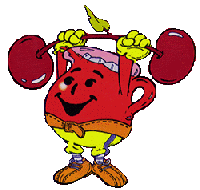
Making Kool-Aid
 |
As a child, almost everyone has made Kool-Aid, or at least watched their mother do it. Therefore, everyone knows that when you pour the sugar and powder in the water, the water goes from clear water to red (for fruit punch Kool-Aid). It also changes its flavor from water to that of sugary Kool-Aid. Although everyone has witnessed this happen, and has enjoyed a glass of Kool-Aid, not everyone has stopped to wonder why the water turns red and tastes sugary. The mixing of Kool-Aid depends on both diffusion of the Kool-Aid powder through the water and the convective mass transfer caused by stirring the contents of the glass. Remember that convective mass transfer is basically diffusion made faster by stirring. Stirring the contents of the glass moves the areas of lower concentration of Kool-Aid to the areas where a lot of Kool-Aid powder exists. |
What do you think would happen if the Kool-Aid were never stirred? Would the water still turn red and sweet, or would the sugary powder stay at the bottom of the container? See Answer.
Return to Mass Transfer
[Introduction |
Kinetics |
Heat Transfer |
Mass Transfer |
Bibliography]